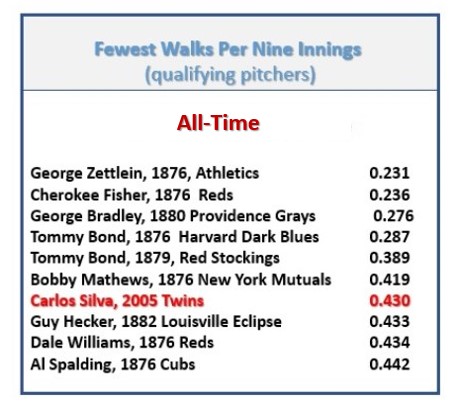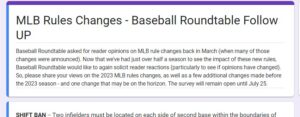 On this Date (July 17) in 1914, 23-year-old righty Charles “Babe” Adams started for the Pirates against future Hall of Famer Rube Marquard (of the Giants). To that point in the season, Adams had gone 7-9, 1.96 – and had walked only 22 batters in 142 1/3 innings pitched (1.4 walks per nine innings). He would be a lot stingier with the free passes on that day. Adams, in fact, would set the MLB record for the most innings pitched in a single outing without giving up a walk. Adams went the distance in a 21-inning, 3-1 Pirates’ loss (the Giants’ Marquard also pitched the full 21 innings). In the 21 frames, Adams gave up just 12 hits – and zero walks – while fanning six,. Marquard gave up 15 hits and two walks, while fanning just two. The game was tied at one apiece after 20 innings, but the Giants got to Adams for two in the top of the 21st – on a single by CF Bob Bescher and an inside-the-park homer by 2B Larry Doyle.
On this Date (July 17) in 1914, 23-year-old righty Charles “Babe” Adams started for the Pirates against future Hall of Famer Rube Marquard (of the Giants). To that point in the season, Adams had gone 7-9, 1.96 – and had walked only 22 batters in 142 1/3 innings pitched (1.4 walks per nine innings). He would be a lot stingier with the free passes on that day. Adams, in fact, would set the MLB record for the most innings pitched in a single outing without giving up a walk. Adams went the distance in a 21-inning, 3-1 Pirates’ loss (the Giants’ Marquard also pitched the full 21 innings). In the 21 frames, Adams gave up just 12 hits – and zero walks – while fanning six,. Marquard gave up 15 hits and two walks, while fanning just two. The game was tied at one apiece after 20 innings, but the Giants got to Adams for two in the top of the 21st – on a single by CF Bob Bescher and an inside-the-park homer by 2B Larry Doyle.
Adams pitched in 19 MLB seasons (1906-07, 1909-16, 1918-26). He pitched for the Pirates in all but the 1906 season (Cardinals). Adams went 194-140, 2.76 and led the NL in fewest walks per nine innings in four straight seasons (1919-22), finishing the league’s top-three in the category in nine times. Side note: If Adams came back to the mound and walked 160 straight batters, he would still have a better career walks-per-nine innings ratio than Hall of Fame corner-painter Greg Maddux.
As always, when Baseball Roundtable researches a topic, one thing always seem to lead to another – and, this time, it led to three trivia questions that can all be answered “Babe Adams.” We’ll get back to our originally scheduled topic – walk-stingy hurlers – but first a look at some Babe Adams not so trivial trivia.
- Who was the first rookie to start a deciding Game Seven of a World Series?
- Who was the first pitcher to throw a shutout in a deciding seventh game of a World Series?
- Who was the fist rookie to win three games in a single World Series?
Adams came into the 1909 seasons having had brief MLB “looks” in 1906-07 — no wins, three losses, 7.96 ERA in five games (so, his rookie status was intact.). Pitching in the minors in Louisville in 1908, he went 22-12. In 1909, he stuck with the Pirates, getting in 25 games (12 starts/seven complete games) and putting up a 12-3, 1.11 record. Adams was far from the star of the Pirates’ staff, which included Howie Camnitz (25-6, 1.62), Vic Willis (22-11, 2.24) and Lefty Leifield (19-8, 2.37). But manager Fred Clarke like liked Adam’s steady composure on the mound, his strong finish to the season and how the rookie’s stuff and style matched up against the Tigers. So, Adams got the Game One start and the rest is history.
Adams earned complete-game wins in Games One and Five, giving up just four earned runs. Then came the deciding Game Seven. (The World Series’ first-ever deciding seventh game.) Adams again went the distance, shutting out the Tigers on six hits (one walk and one whiff). Thus, he pitched and threw a shutout to win the first deciding Game Seven (as a rookie) and also became the first rookie to win three games in a best-of-seven World Series.
Back to our Originally Scheduled Topic … How about 22 Innings Without a Walk?
While Babe Adams holds the single-pitcher, single-game record for most innings pitched without issuing a walk, on August 23, 1989, the Expos’ staff set an MLB record by going 22 innings without issuing a single walk (intentional or non-intentional). The Dodgers, who had 20 hits in the game (the Expos had 13) won the contest on a Rick Dempsey home run (off Dennis Martinez) in the top of the 22nd frame. In the game, Montreal starter Pascual Perez went the first eight innings and only went to a three-ball count on one batter (3-2 before fanning Dodgers’ LF Lenny Harris in the first frame). In fact, over the first 18 innings, Expos’ hurlers – they used six in the game – reached three balls on only three batters. (The Baseball-Reference.com pitch-by-pitch only goes through the first 18 innings, so I need to do a bit more research on this one.)
Side Note: In this game, Youppi – the Expos’ mascot – was ejected in the 11th inning. (Perhaps he had a date.)
More on Stingy Pitcher .s
 Here’s another trivia question: “What qualifying pitcher has the lowest single-season walks per nine innings mark since the four-ball walk rule was instituted?” (Four balls became a walk in 1888, prior to that walks were – at varying times – nine, eight, six and five balls. Thanks to great research by Society for American Baseball Research member Richard Hershberger.) The answer? Carlos Silva, who – as a Twin in 2005 – walked just nine batters (and one of those was intentional) in 188 1/3 innings – a stingy 0.430 walks per nine frames rate. Note: Baseball-Reference.com indicates Negro League rankings are not yet complete.
Here’s another trivia question: “What qualifying pitcher has the lowest single-season walks per nine innings mark since the four-ball walk rule was instituted?” (Four balls became a walk in 1888, prior to that walks were – at varying times – nine, eight, six and five balls. Thanks to great research by Society for American Baseball Research member Richard Hershberger.) The answer? Carlos Silva, who – as a Twin in 2005 – walked just nine batters (and one of those was intentional) in 188 1/3 innings – a stingy 0.430 walks per nine frames rate. Note: Baseball-Reference.com indicates Negro League rankings are not yet complete.
You could follow up this question with: “How many right-handed hitters did Carlos Silva walk in 2005?” The answer is one – the Tigers’ Craig Monroe – and that was Silva’s one intentional walk. So, not a single righty was able to “work him” for a walk all-season. Monroe, by the way, drew only 40 walks in 623 plate appearance n 2005. You might also be interested to know that Silva is the only pitcher – among the 25 best single-season walks per nine rates – whose landmark season came after the four-ball walk rule came into effect.
Silva pitched nine MLB seasons (2002-10 … Phillies, Twins, Mariners, Cubs) and went 70-70, 4.68. He walked 238 batters in 1,241 2/3 innings – 1.5 per nine frames.
Another One Thing Leads to Another – No “True Outcomes”
Looking at walks takes you right into – in today’s terminology – the “Three True Outcomes.” That would be walks, strikeouts and home runs – which have become an increasingly frequent part of the national pastime.
I decided to go on a search (Baseball-Reference.com and Retrosheet.org) for games in which there were no “True Outcomes.” Focusing on the Modern Era – post 1900 – I was only able to confirm two games of at least nine innings in which neither team recorded a walk, a strikeout or a home run.
On August 28, 1924 – as the Indians topped the White Sox 7-0 in the first game of a double header – the two teams combined for 21 hits, seven runs and four errors – but not a single walk, whiff or long ball. The White Sox had eight hits (seven singles and a double), while the Indians knocked 13 hits, including two doubles and a triple. The winning pitcher was Sherry Smith (nine innings pitched, eight hits and, of course, no walks or strikeouts), while the losing hurler was Hollis Thurston (eight innings pitched, 13 hits, seven runs/five earned). The second game of that twin bill, by the way, also saw no round trippers, but did include a combined total of 16 walks and ten strikeouts.
On June 20, 1922, as the Braves topped the Robins (Dodgers)in Boston 3-2, the two squads put up a combined 16 hits and three errors, but no walks, strikeouts or home runs. All five runs in the contest were unearned. The winning pitcher in this one was Dana Fillingim, who gave up seven hits and two unearned runs in nine innings. The loser was Leon Cadore (eight innings, nine hits, three unearned runs.) Each team had just one extra base hit – a double. The day after their no true outcome contest, the two teams combined for just one run (Robins 1 – Braves 0) on 14 hits, no home runs, four walks and six whiffs.
Primary Resource: Baseball-Reference.com
WE WANT YOUR OPINION
THERE IS STILL TIME TO VOTE IN BASEBALL ROUNDTABLE’S POLL COLLECTING FAN OPINIONS ON MANY OF MLB’S NEW RULES. CLICK HERE TO ACCESS THE BALLOT.
Baseball Roundtable – Blogging Baseball Since 2012.

 Baseball Roundtable is on the Feedspot list of the Top 100 Baseball Blogs. To see the full list, click here.
Baseball Roundtable is on the Feedspot list of the Top 100 Baseball Blogs. To see the full list, click here.
Baseball Roundtable is also on the Anytime Baseball Supply Top 66 Baseball Sites list. For the full list, click here.
I tweet (on X) baseball @DavidBaseballRT
Follow/Like Baseball Roundtable’s Facebook Page here. Find More baseball commentary; blog post notifications; PRIZES.
Member: Society for American Baseball Research (SABR); Negro Leagues Baseball Museum; The Baseball Reliquary.







